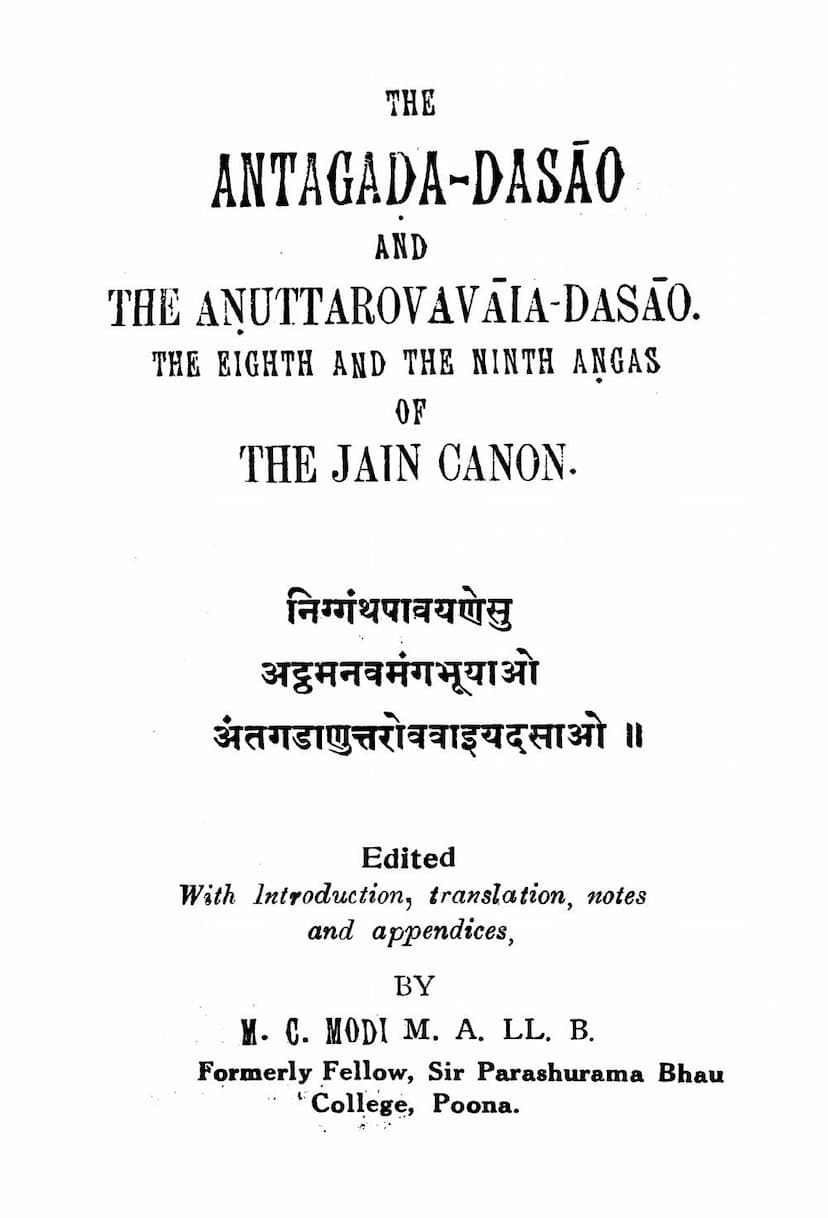Antagadadasao And Anuttarovavaidasao
Added to library: September 1, 2025

Summary
The book "Antagadadasao and Anuttarovavaiya-Dasao" by Madhusudan Modi, published by Gurjar Granth Ratna Karyalay, Ahmedabad, presents a critical edition of two important scriptures of the Jain Canon: the Antagadadasao (Eighth Anga) and the Anuttarovavaiya-Dasao (Ninth Anga). The author, H. C. Modi, M.A., LL.B., aimed to provide scholars and students with critically edited texts of these scriptures, considering the existing Jain Canon publications were often carelessly edited and now out of print.
Introduction: The introduction highlights the importance of critical editions of Jain scriptures, lamenting the lack of attention compared to Buddhist canons. It outlines the textual basis for this edition, which relies on four manuscripts and the Agamodaya Samiti edition. The manuscripts used, mostly paper manuscripts not earlier than the 15th century Vikrama Era, are described in detail, including their provenance (Patan and Bhavanagar) and specific collection details. The author acknowledges the limitations due to time constraints and the inability to access older palm-leaf manuscripts.
The introduction also delves into several critical aspects:
- Textual Criticism: It discusses the challenges of settling spellings and grammatical forms due to manuscript variations and scribe errors. Instances of common errors and difficulties in determining the original readings are provided. The author notes the damage done to scriptures by time, neglect, and inaccuracies.
- Historical Context of the Jain Canon: It traces the possible formulation of the Angas by Mahavira's disciples from the Purvas, the religious sermons of Mahavira, and stories of distinguished disciples. It touches upon the loss of the 12th Anga, Ditthivaya, and the Purvas, attributing it to internal dissensions, famines, and neglect. The councils of Pataliputra, Mathura, and Valabhi are mentioned as attempts to reorganize the scriptures.
- Language of the Jain Canon: The introduction extensively discusses the language, identified as Ardhamagadhi. It explores the origin of this name, its deviation from classical Magadhi, and its characteristics, suggesting a mixed influence from Eastern Magadhi, South-western Maharastri, and Western Sauraseni. Hypotheses regarding the deliberate use of a mixed dialect for wider audience or linguistic changes due to textual vicissitudes are explored.
- Contents and Style: The introduction analyzes the contents of Antagadadasao, noting its division into six divisions or Vaggas, and identifying three strata in its formation, representing pre-Mahavira stories and stories of Mahavira's disciples. It highlights the tragic story of Gayasukumala and the prediction of Kanha Vasudeva's death. The Anuttarovavaiya-Dasao is noted for its interest primarily in the story of Dhanna. The style of both scriptures is described as mechanical, with a vast number of recurring phrases, resembling Buddhist scriptures and also the prose style of Brahmanas and Upanishads. Long compounds and ornate descriptions are considered later additions.
The Scriptures:
-
Antagadadasao (Eighth Anga):
- This scripture is divided into eight Vaggas (Divisions).
- Each Vagga contains a specific number of lessons (Adhyayanas).
- The text meticulously details the narrative of heroes and their ascetic paths, often featuring stories of renunciation, severe penances, and eventual liberation (Siddha).
- The stories often revolve around the city of Bāravai and its prominent figures like Kanha Vasudeva, Baladeva, and their descendants, as well as the twenty-second Tirthankara, Aritthanemi.
- The penances performed by various queens and disciples are described in intricate detail, highlighting their ascetic practices, fasting regimens, and spiritual attainment. The text often refers back to previous stories (like those of Meha, Khandaka, Mahabbala) for narrative parallels.
- A significant portion of the text focuses on the lifestyle and austerities undertaken by individuals, often involving extreme fasting and self-mortification, leading to their ultimate salvation. The detailed descriptions of physical transformations due to penance are a notable feature.
-
Anuttarovavaiya-Dasao (Ninth Anga):
- This scripture is divided into three Vaggas (Divisions).
- The text focuses on individuals who are reborn in the Highest Mansions (Anuttara Vimana).
- It presents stories of various individuals who, after undertaking intense asceticism and fulfilling specific penances, attain celestial rebirths in these highest heavens.
- The narratives often follow a similar structure: the individual's worldly life, their encounter with a religious figure (like Mahāvīra or his disciples), their renunciation, ascetic practices, and eventual attainment of a celestial state or liberation.
- The stories of Jali, Dhanna, Sunakkhatta, and the penances performed by various queens and ascetics are prominent. The text emphasizes the concept of karma and the results of one's actions leading to different states of existence.
Commentary (Parishishta): The book includes a commentary by Shrīmad Abhayadeva Sūri for both scriptures. The commentary offers etymological explanations, clarifies difficult passages, and provides context by referencing other Jain scriptures, particularly the Bhagavati Sūtra (the Fifth Anga). It also elaborates on the philosophical and practical aspects of the penances and vows described.
Appendices: The book contains appendices that further enrich the understanding of the text:
- Appendix I: The commentary of Abhayadeva Sūri.
- Appendix II: A collection of recurring passages ([quusit], etc.) that are referenced in the text proper for brevity.
- Appendix III: A description of Jain Cosmography, explaining the concepts of hells, heavens, and the universe as conceived in Jain theology, with detailed charts.
Glossary: A comprehensive glossary is provided, explaining various Prakrit and Sanskrit terms used in the scriptures, aiding the reader's comprehension.
In essence, this book is a scholarly endeavor to make accessible two crucial texts within the Jain canon, offering a deep dive into the lives of ascetics and the paths to liberation as depicted in Jain tradition, supported by critical textual analysis and historical context.